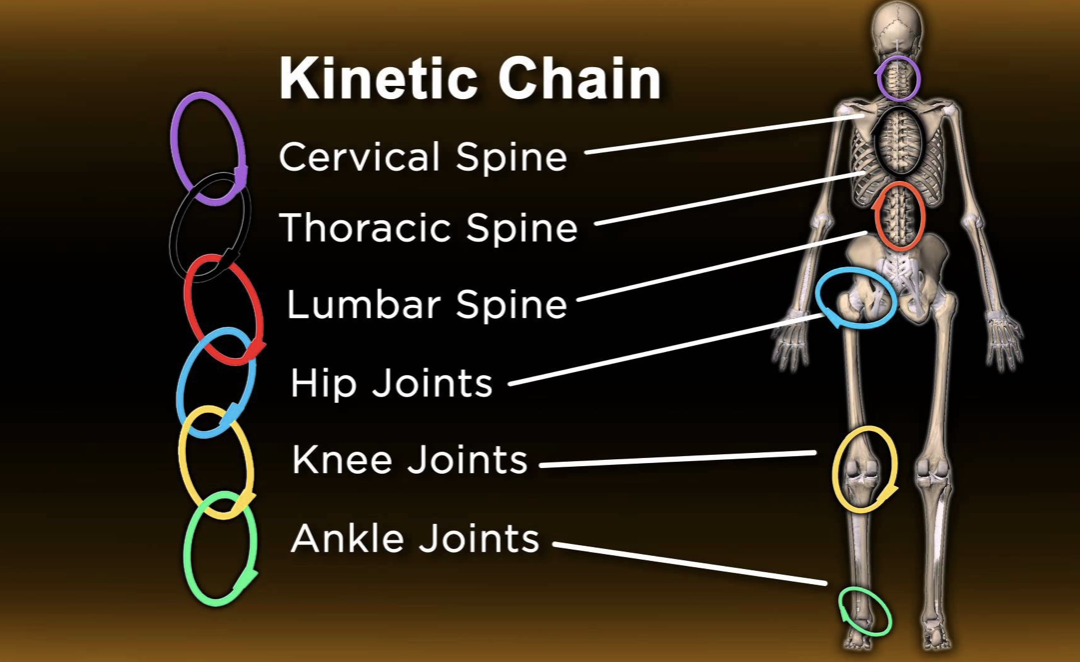HOW THE KINETIC CHAIN CAN CAUSE INJURY TO OTHER SEGMENTS OF THE BODY.
There are often many injuries that people think have come from impact during sport or from performing an unfamiliar task. Quite often these injuries actually stem from your body’s linked structure (the kinetic chain) which highlights that when one part of the body is inefficient, another area of the body will suffer.
These injuries can occur due to preventable factors such as misalignment, poor postural positions or an imbalance of strength. The below information highlights 3 problems and 3 fixes that will help keep you injury-free this winter.
FEET
Problem:
- Problems with the feet can lead to excessive strain on other structures higher up in the body which can lead to ankle, shin, knee, hip or lower back pain.
- One of the most common issues that particularly runners have is the pronation of your foot. A pronated foot rolls inwards at the ankle, the midfoot bulges inwards and the arch of the foot flattens.
- When this pronation occurs the knee and hip then rotate inward, placing stress on different muscles and structures surrounding the knee, hip and lower back and causing pain in these areas.
- Pain is experienced especially during running.
Functional Fix:
Strengthen your arch but doing the following exercises:
- Exercise 1. Balance Exercise.
> Begins with your eyes open and try to balance for > 30s
> Progress by closing your eyes.
> Progress by adding an unstable surface.
- Exercise 2. Towel Pickup Exercise
> Place a towel on the ground.
> Scrunch the towel up with your foot and repeat 10 – 15 times multiple times per day.
FOLLOW THE LINK:
https://www.youtube.com/watchv=q011GgYz3OI&index=12&list=UU5mZkAjsDgjDf5poPquKtWg
- 3. Release The Fascia
> Foam Roll/ Spikey Ball (start with tennis ball) for 3-5 mins
> Progress to a harder ball
> This will help improve flexibility and release any tightness you may be experiencing
FOLLOW THE LINK: https://www.youtube.com/watch?v=q011GgYz3OI&index=12&list=UU5mZkAjsDgjDf5poPquKtWg)
Other advice would be to have a running gait assessment, see a podiatrist for orthotics or have shoes properly fitted for you.
KNEES
The Problem:
- Knee Pain
This can often be caused by imbalances between the muscles of the leg. The muscles in the front of the leg attach to the front of the shin, the muscles in the back of the leg attach to the back of the shin. Therefore, if the muscles on one side are stronger or tighter than the muscles on the other side, they are able to create a pulling force on the knee which can move it out of optimal position. This means, that there is more stress on certain areas of the knee that are designed to rub together.
Functional fix:
> Program a basic leg session that incorporates an equal amount of anterior (quadriceps + tibialis anterior) and posterior exercises (hamstring, glutes and calves).
i.e.:
A1) BB Back Squat
A2) BB Romanian Dead Lifts
B1) DB Split Squats
B2) Glute Bridges
C1) Calf Raises
C2) Wall Sit
> Test your maximum single leg strength. Do this unilaterally (one leg) through single leg quadricep extension and single leg hamstring flexion to see what your baseline strength is and if there are significant differences between legs and also hamstrings vs quads. If there are make the necessary changes to your program.
HIPS
The Problem
- Incorrect Hip Function & Poor activation of the glutes. The hip can often cause problems with the knee due to incorrect function causing the knee to be put in the wrong position, twisting and torquing which can cause excessive wear and tear or in extreme cases sudden snapping of the ligaments holding the knee stable. We often see a weakness in the hip muscles that can cause the hip to be placed in a poor position. This is particularly common of the gluteal muscles. This means that other areas of the body will overcompensate for this weakness, becoming over utilised and fatigued. It also means that if you can’t utilise your gluteals – you will not produce your maximum force output. We often see this in many of our clients.
Functional Fix:
Get your posture assessed by a professional and obtain a specific program.
> Learn how to ‘activate’ your glutes (see our glute activation series (vid 16/17) on how to do this.
CLICK BELOW:
https://www.youtube.com/channel/UC5mZkAjsDgjDf5poPquKtWg?view_as=subscriber.
> Perform remedial and self-myofascial release exercises such as spikey balling & foam rolling your glutes to release tightness that may be causing an imbalance.
> Release your Psoas and other hip flexor muscles that may be pulling on your hips or spine.
CLICK BELOW:
https://www.youtube.com/watch?v=tXAZ5fTftc&index=8&list=UU5mZkAjsDgjDf5poPquKtWgOther tips:- Avoid sitting for prolonged periods of time especially in a poor position.
In Closing…I hope that this information highlights how one area of the body can affect the other and cause pain and injury. Obviously, it is much more complex than what I have discussed but the main take-home message is that if you are having a joint problem on one area – it is very likely that it is being caused by another area. We often see people in knee braces playing sports whilst they still have poor biomechanics and incorrect movement patterns which are actually causing the pain. This will not solve your problem and it could, in fact, make the injury worse.
Start focusing on your posture, how you are moving AND WHAT YOU CAN DO TO CHANGE THIS!
Dan Maitland
Owner – TrainingwithMates
SEND US AN EMAIL > info@trainingwithmates.com.au

